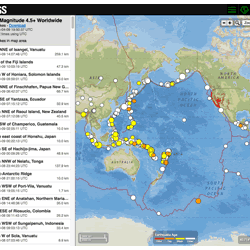Map of earthquakes in the Yellowstone National Park region in 2023
Map of earthquakes in the Yellowstone National Park region in 2023Map of seismicity (red circles) in the Yellowstone region during 2023. Gray lines are roads, black dashed line shows the caldera boundary, Yellowstone National Park is outlined by black dot-dashed line, and gray dashed lines denote state boundaries.


















